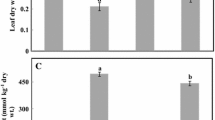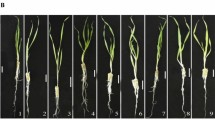Abstract
Salicylic acid (SA) is a signaling compound that plays an important role in plant responses to biotic and abiotic stress. Exogenous application of SA can improve abiotic stress tolerance in various plants, a response that varies depending on the nutrient status of the plant. Based on the hypothesis that the nutrient status of a plant affects SA-induced stress tolerance, we investigated SA-induced stress tolerance in cucumber grown under moderate nitrogen (MN, 120 ppm) and low nitrogen (LN, 40 ppm) conditions. Cucumbers grown under MN conditions showed SA-induced tolerance to salt stress, along with mild increases in endogenous SA levels. In cucumbers without SA pretreatment, the increase in endogenous SA levels after salt stress treatment was approximately 2-fold higher than that of SA-pretreated plants. On the other hand, exogenous SA did not increase salt-stress tolerance in plants grown in LN exhibiting leaf chlorosis, although SA levels increased in the leaves of these plants. These results indicate that exogenous SA-induced salt stress tolerance is well established in cucumber grown in MN. In addition, SA pretreatment can improve the ability of plants to regulate endogenous SA levels after salt stress when grown under suitable nutrient conditions.
Similar content being viewed by others
Literature Cited
Aebi H, Wyss SR, Scherz B, Skvaril F (1974) Heterogeneity of erythrocyte catalase II. Eur J Biochem 48:137–145
Arnon DI (1949) Copper enzymes in isolated chloroplasts phenoloxidase in Beta vulgaris. Plant Physiol 24:1–15
Borsani O, Valpuesta V, Botella MA (2001) Evidence for a role of salicylic acid in the oxidative damage generated by NaCl and osmotic stress in Arabidopsis seedlings. Plant Physiol 126:1024–1030
Bradford MM (1976) A rapid and sensitive method for the quantitation of microgram quantities of protein utilizing the principle of protein-dye binding. Anal Biochem 72:248–254
Dong CJ, Li L, Shang QM, Liu XY, Zhang ZG (2014) Endogenous salicylic acid accumulation is required for chilling tolerance in cucumber (Cucumis sativus L.) seedlings. Planta 240:687–700
Dong CJ, Wang XL, Shang QM (2011) Salicylic acid regulates sugar metabolism that confers tolerance to salinity stress in cucumber seedlings. Sci Hortic 129:629–636
Dong J, Wan G, Liang Z (2010) Accumulation of salicylic acid-induced phenolic compounds and raised activities of secondary metabolic and antioxidative enzymes in Salvia miltiorrhiza cell culture. J Biotechnol 148:99–104
Durrant WE, Dong X (2004) Systemic acquired resistance. Annu Rev Phytopathol 42:185–209
El-Tayeb MA (2005) Response of barley grains to the interactive effect of salinity and salicylic acid. Plant Growth Regul 45:215–224
Enyedi AJ, Raskin I (1993) Induction of UDP-glucose: salicylic acid glucosyltransferase activity in tobacco mosaic virus-inoculated tobacco (Nicotiana tabacum) leaves. Plant Physiol 101:1375–1380
Foyer CH, Halliwell B (1976) The presence of glutathione and glutathione reductase in chloroplasts: a proposed role in ascorbic acid metabolism. Planta 133:21–25
Ganesan V, Thomas G (2001) Salicylic acid response in rice: influence of salicylic acid on H2O2 accumulation and oxidative stress. Plant Sci 160:1095–1106
Hayat Q, Hayat S, Irfan M, Ahmad A (2010) Effect of exogenous salicylic acid under changing environment: A review. Environ Exp Bot 68:14–25
Hayat S, Ali B, Ahmad A (2007) Salicylic acid: biosynthesis, metabolism and physiological role in plants. In S Hayat, A Ahmad eds, Salicylic Acid: A Plant Hormone, Springer, Netherlands, pp 1–14
Heath RL, Packer L (1968) Photoperoxidation in isolated chloroplasts: I. Kinetics and stoichiometry of fatty acid peroxidation. Arch Biochem Biophys 125:189–198
Horváth E, Pál M, Szalai G, Páldi E, Janda T (2007a) Exogenous 4-hydroxybenzoic acid and salicylic acid modulate the effect of short-term drought and freezing stress on wheat plants. Biol Plant 51:480–487
Horváth E, Szalai G, Janda T (2007b) Induction of abiotic stress tolerance by salicylic acid signaling. J Plant Growth Regul. 26:290–300
Hunt JE, McNeil DL (1998) Nitrogen status affects UV-B sensitivity of cucumber. Aust J Plant Physiol 25:79–86
Kadioglu A, Saruhan N, Sağlam A, Terzi R, Acet T (2011) Exogenous salicylic acid alleviates effects of long term drought stress and delays leaf rolling by inducing antioxidant system. Plant Growth Regul 64:27–37
Lee HI, León J, Raskin I (1995) Biosynthesis and metabolism of salicylic acid. Proc Natl Acad Sci USA 92:4076–4079
Logan BA, Demmig-Adams B, Rosenstiel TN, Adams III WW (1999) Effect of nitrogen limitation on foliar antioxidants in relationship to other metabolic characteristics. Planta 209:213–220
Maathuis FJ (2009) Physiological functions of mineral macronutrients. Curr Opin Plant Biol 12:250–258
Malamy J, Hennig J, Klessig DF (1992) Temperature-dependent induction of salicylic acid and its conjugates during the resistance response to tobacco mosaic virus infection. Plant Cell 4:359–366
Metwally A, Finkemeier I, Georgi M, Dietz KJ (2003) Salicylic acid alleviates the cadmium toxicity in barley seedlings. Plant Physiol 132:272–281
Mittler R (2002) Oxidative stress, antioxidants and stress tolerance. Trends Plant Sci 7:405–410
Mutlu S, Atici Ö, Nalbantoglu B (2009) Effects of salicylic acid and salinity on apoplastic antioxidant enzymes in two wheat cultivars differing in salt tolerance. Biol Plant 53:334–338
Nakano Y, Asada K (1981) Hydrogen peroxide is scavenged by ascorbate-specific peroxidase in spinach chloroplasts. Plant Cell Physiol 22:867–880
Nazar R, Iqbal N, Syeed S, Khan NA (2011) Salicylic acid alleviates decreases in photosynthesis under salt stress by enhancing nitrogen and sulfur assimilation and antioxidant metabolism differentially in two mungbean cultivars. J Plant Physiol 168:807–815
Power SA, Ashmore MR, Cousins DA, Sheppard LJ (1998) Effects of nitrogen addition on the stress sensitivity of Calluna vulgaris. New Phytol 138:663–673
Rao MV, Paliyath G, Ormrod DP, Murr DP, Watkins CB (1997) Influence of salicylic acid on H2O2 production, oxidative stress, and H2O2-metabolizing enzymes. Plant Physiol 115:137–149
Rivas-San Vicente M, Plasencia J (2011) Salicylic acid beyond defence: its role in plant growth and development. J Exp Bot 62:3321–3338
Sawada H, Shim IS, Usui K (2006) Induction of benzoic acid 2-hydroxylase and salicylic acid biosynthesis—Modulation by salt stress in rice seedlings. Plant Sci 171:263–270
Scott IM, Clarke SM, Wood JE, Mur LAJ (2004) Salicylate accumulation inhibits growth at chilling temperature in Arabidopsis. Plant Physiol 135:1040–1049
Shi Q, Zhu Z (2008) Effects of exogenous salicylic acid on manganese toxicity, element contents and antioxidative system in cucumber. Environ Exp Bot 63:317–326
Shim IS, Momose Y, Yamamoto A, Kim DW, Usui K (2003) Inhibition of catalase activity by oxidative stress and its relationship to salicylic acid accumulation in plants. Plant Growth Regul 39:285–292
Sugiharto B, Miyata K, Nakamoto H, Sasakawa H, Sugiyama T (1990) Regulation of expression of carbon-assimilating enzymes by nitrogen in maize leaf. Plant Physiol 92:963–969
Sung JK, Lee NR, Choi JM. (2016) Growth of chinese cabbage plug seedlings as influenced by various pre-planting nitrogen concentrations in inert media. Korean J Hortic Sci Technol 34(4):616–625
Szepesi Á, Csiszár J, Bajkán S, Gémes K, Horváth F, Erdei L, Deér AK, Simon ML, Tari I (2005) Role of salicylic acid pre-treatment on the acclimation of tomato plants to salt-and osmotic stress. Acta Biol Szeg 49:123–125
Terashima I, Evans JR (1988) Effects of light and nitrogen nutrition on the organization of the photosynthetic apparatus in spinach. Plant Cell Physiol 29:143–155
Turkyilmaz Unal B, Mentis O, Akyol E (2015) Effects of exogenous salicylic acid on antioxidant activity and proline accumulation in apple (Malus domestica L.). Hortic Environ Biotechnol 56:606–611
Verhoeven AS, Demmig-Adams B, Adams III WW (1997) Enhanced employment of the xanthophyll cycle and thermal energy dissipation in spinach exposed to high light and N stress. Plant Physiol 113:817–824
Vlot AC, Dempsey DMA, Klessig DF (2009) Salicylic acid, a multifaceted hormone to combat disease. Annu Rev Phytopathol 47:177–206
Yalpani N, Enyedi A, León J, Raskin I (1994) Ultraviolet light and ozone stimulate accumulation of salicylic acid, pathogenesis-related proteins and virus resistance in tobacco. Planta 193:372–376
Yoshida S, Fomo D, Cock J, Gomez K (1976) Laboratory manual for physiological studies of rice. International Rice Research Institute, Manila, Philippines
Author information
Authors and Affiliations
Corresponding author
Electronic supplementary material
13580_2017_111_MOESM1_ESM.xlsx
Supplementary Fig. 1. Time course of APX and GR activity in cucumber seedlings exposed to 120 mM NaCl. Cucumber seedlings were pretreated with nutrient solution containing 0.1 mM SA for 2 days prior to NaCl treatment. The third leaf of each plant was sampled for measurement. Vertical bars indicate ± S.D. (n = 3)
Rights and permissions
About this article
Cite this article
Kim, Y., Kim, S. & Shim, IS. Exogenous salicylic acid alleviates salt-stress damage in cucumber under moderate nitrogen conditions by controlling endogenous salicylic acid levels. Hortic. Environ. Biotechnol. 58, 247–253 (2017). https://doi.org/10.1007/s13580-017-0111-7
Received:
Revised:
Accepted:
Published:
Issue Date:
DOI: https://doi.org/10.1007/s13580-017-0111-7




